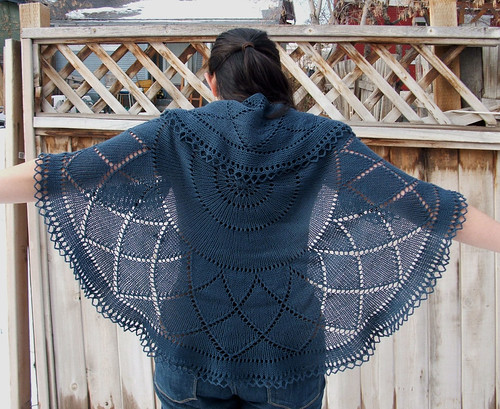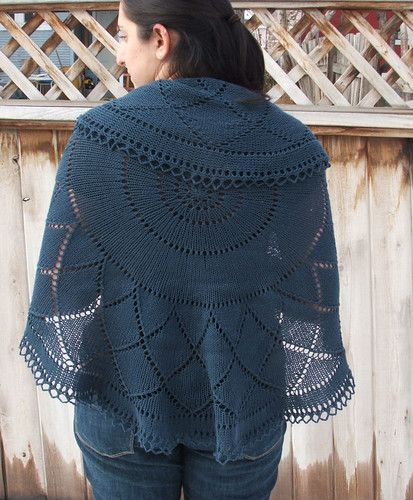Now that my technical difficulties are solved and my blog is running as it should, I thought I’d finally address something that’s been weighing heavily on my mind of late. So heavily, that it’s been responsible for my sluggish creativity and a bit of depression. The post is long, but please take the time to read it, I feel it’s an important issue.
Even though designing handknitting patterns isn’t my primary source of income, I take it seriously. I have a business plan, a business license, long-term projections, investments, etc…. I guess that’s what comes of a 4 year business degree. I have set break even points for my patterns and I track the income I make from them so I have an idea of where I am and I reinvest profits back into the business.
Some patterns exceed my expectations and make a profit after the first month or two, and some fall short for reasons I may never quite understand. Whether I am self-publishing, or doing a piece for a yarn company, I will not sell my copyright. I will only license publication rights or give a term of exclusivity with any other company, but I retain rights to my work. This gives me the option of teaching from those patterns, republishing online, selling wholesale… etc…. (for a good, basic breakdown on publishing and contracts, I highly recommend Jenna’s post on the subject. Even if you’re not a designer, if you want to be a conscientious consumer, you should read it.)
As Jenna cautions in her post, the publishers are out to make money. They’re not in the business of benevolently offering up-and-coming designers the chance to achieve their dreams. They are out to make money, and it’s important for the designers to know that and to not sign away more than they’re willing to give. Every contract is negotiable before it is signed, but once you sign, you’re legally obligated to abide by that contract, so it would be prudent for designers to push to get a contract in place BEFORE receiving yarn and BEFORE the deadlines are set. It’s much better in the long run than if the designer finds herself backed up against a deadline, with the knitted piece nearly finished, staring at a new contract that makes her feel less than comfortable with the arrangement and not getting e-mail responses from the people in charge. Ask me how I know.
With my business model, when I have published a pattern in a magazine, I expect that after whatever period of exclusivity, I will regain rights to publish the pattern and then I can continue making a profit from that design. For instance, what Interweave paid for first North American serial rights for Icarus just barely covers my break even point, but leaves me making no profit from the design. When you break down all the time spent for a design from initial concept through to making charts, sizing, and knitting the model, the average magazine pattern fee ends up being less than minimum wage for all the time put into it. And that doesn’t even cover all the time spent giving help and technical support through e-mail to the people knitting the magazine pattern. So after a while, I republished the pattern (which was within my contracted rights to do), and now I can make a profit from it.
To cover all their bases and to cover older contracts that didn’t have a provision for digital distribution, Interweave sent out a Digital Revenue Sharing Contract to every designer who had contributed to their publications. Interweave insists that the DRSC only licenses rights to publication and that the contract is not meant to interfere with the ability of a designer to self-publish after the original publication, but to become an additional source of income (10% of whatever price Interweave decides to set for the pattern, which could be nothing. As we all know, 10% of nothing is still nothing). But the very intelligent IP lawyer I hired says otherwise. The contract is written as an assignation of rights. Which means that had I signed the DRSC, I would loose rights to publish my patterns (Icarus and Logan River Wrap) in any medium; digitally, print or wholesale. When I told Interweave of my problems with the contract, they didn’t respond for 3 weeks and then told me they would not negotiate. So I didn’t sign the agreement. Annie Modesitt covers a bit of the history and why she didn’t sign it in this post.
But here’s where it gets sticky. Interweave’s lack of my signature on their DRSC doesn’t preclude them from selling my patterns digitally. Even leaving aside the DRSC, with Interweave’s new online store, which sells pdfs, if I were to sell the the Logan River Wrap after the 1 year exclusivity period that was in the contract for that piece, it could be considered direct competition. Selling the same pattern in the same format, via the same medium. (Although there is a questionable point whether I adapt the pattern, or rework it, if that is considered a whole new pattern and therefore not governed by the same agreement). But because of the contract I signed for the Logan River Wrap, I have to expect that it’s basically lost to me for all future digital profits, because if I sell it through my normal channels, it could be in competition with Interweave’s new online store.
Icarus, having been under a different contract, is governed differently. There was no exclusivity period for Icarus, nor was there any provision against competing with Interweave in selling the pattern in future. But Interweave also has the right under contract to offer Icarus in digital format. So they could, theoretically, give the Icarus pattern away for free, and effectively prevent me from selling it. Who would want to PAY for a pattern they could get for free, right?
So at some point, Icarus and Logan River Wrap might show up in their online store, either for free or for a price, but I will not be receiving any revenue from those purchases. I think it’s important to be an informed consumer, no matter what venue you are purchasing in and I understand, from a consumer perspective, how easy and convenient it is to buy patterns from Interweave’s online store instead of spending time tracking down an out of print issue on ebay or trying to be a good knitter and not photocopy the pattern from a friend’s copy of the mag. I’m not calling for a boycott of Interweave, by any means, but if you like what independent designers offer you and you are wanting to support them, I would highly advocate buying directly from the designer’s website or store when possible. If you value the work indie designers put into their patterns, then support them.
Thanks for sticking with me through this post. Let me know your thoughts, even if you disagree with me. I’ve struggled long and hard with how to phrase this and whether to say anything, but I can’t stay silent any longer on the subject.
Mim



















